The scouts sent to investigate the promised land came back and reported that there were giants living in the land. Well, those guys may not be around any more, but there are some things that seem to be gigantic here:
The Kiwis are bigger than any I’ve found in the States!
The first stop on Day 4 was Kursi located east of the Sea of Galiliee. In 1970 during road construction, this site was accidentally found. It includes the remains of the largest Byzantine (Roman Christian era) monastery in the Holy Land.
This site, according the a strong Christian tradition is the location of the miracle of the swine, where Jesus cured two madmen (Matt. 8:28-32). While Margi holds the map and Yoel gives us an overview of the area, note the hills in the background. While there is one other area along the Sea of Galilee that some have concluded is the place for this miracle of Jesus, of the two, Kursi has the correct geography to match the description of the herd of pigs running a steep embankment into the sea.
Original flooring designs.
Standing in the sanctuary with Yoel at the chancel.
Off the sanctuary is a room with a baptistery. This style was an impression in the floor in which the catechumenate would stand and have water poured over their head.
Then on to a nature reserve near Tel Dan at the Northern end of Israel in the Golan Heights. The beautiful, fast flowing Dan River is one of the three sources of the Jordan River. The city remains at Dan are an interesting story. The tribe of Dan was allotted land along the coast of the Mediterranean, but was not able to drive out the Canaanites in that area. In time, some of them became of this beautiful area and the city of Laish found there. They captured the city and renamed it Dan. (Judges 18:27-29).
The impressive walls are not the walls of Laish that the Danites had to contend with, as this city was built up later by the Israelites themselves.
And these Israelite walls were impressive!
Approaching the Israelite main gate, which was built around and beyond the original gate of Laish, providing an inner courtyard for conducting business or interacting with people without letting them in to the main city.
A paved entry way, but very rounded and uneven. Either these used to be smooth and have all been weathered down or the ancients had very strong ankles because it isn’t easy walking!
The seat inside the courtyard where the king might sit. When the kingdom was divided and Jeroboam began ruling as the first king of the northern kingdom, he would have sat here to hear from his people. Instead, we find Queen Jerry-boam fulfilling that task.
And while she waits to hear their requests, the peasants sit on the bench to the right to await their hearing.
One of the side chambers of the inner (Canaanite) gate.
Hard to tell from this pic of my arm stretched over the top of the exterior wall (above where I was standing below it in the other picture), but the top is at least 8 feet thick. No doubt thicker at the base.
The remains of the road entering into the city between the inner gate chambers (or what is left of them!). One great historic find is the remains of an inscription from Hazael, King of Damascus bragging of his conquest over Israel and the “house of David”. Set up to proclaim his victory, but later broken and used for construction by the Israelites. This was the first discovery of the term “House of David” outside the bible and is part of a growing body of evidence that the Bible’s historical accounts are correct and the claims of the critical scholars over the past century (that they events didn’t happen as told or that some of the key biblical persons didn’t actually exist) are increasingly shown to be incorrect.
Also at Tel Dan is the remains of one of the two High Places that King Jereboam set up after the kingdom was divided. He did not want his people going to Jerusalem in the Kingdom of Judah, so he erected two golden calves, one of which was at Dan, so that his people could worship the Lord in their own land. We didn’t get to see that part of the site, but more can be read here:
http://generationword.com/Israel/dan.html
Lastly, at Tel Dan, just around the corner and under a hill, were recently found the remains of an ancient city center, reconstructed here. This is the gate of city built of mud bricks on basalt standing stones.
This entryway from the 18th century BC is often called “Abraham’s Gate” because the scriptures tell us that when he was rescuing his nephew Lot from capture, he pursued the enemies “all the way to Dan” (Gen. 14:14), meaning the city that is found where Dan now stands. Abraham may well have traveled on this path and entered this now blocked up gate.
From there to another nature reserve surrounding Banias. As is often the case at these historic sites, various artifacts found are set up on display as pictured here. The beginnings of a stream is found here receiving its water from the southern slopes of Mt. Hermon. Most of the water emerges from springs at the base of the Banias Cave.
The cave from a distance. Also seen are more recent pools that are made to hold/slow the waters of the stream. The term Banias is the Arabic pronunciation of the Greek god Paneas, or Pan. A temple was constructed to him here. Later, when the Romans annexed this area to Herod the Great’s territory, Herod built a temple to Emperor Augustus. This area was later to be called Caesarea Philipi when Herod’s son Philip ruled this portion of the territory after Herod’s death.
The group in front of the cave, once filled with water into which animal sacrifices were offered to Pan. (Some say even human sacrifices were offered).
Thanks to an earthquake and a partial collapse of the rocks above, the pool of water no longer exists, with the spring coming out further down the hillside.
Some traditions claim that this location also became known as a gate to hell.
An illustration showing the Roman era constructions, including the temple to Augustus on the left in front of the Cave of Pan. It is way up here in the north of Caesarea Philipi where Jesus brings his disciples to ask them “Who do you say that I am” and where Peter answers, “You are the Messiah, the Son of the Living God.” Here in front of the temple to Augustus, who called himself the “son of god”, Peter confesses that Jesus is the true Son of the true God. To this Jesus states that he will build his church upon this faithful confession and the gates of hell will not prevail against it. A conversation made even more significant by the place in which it is carried out.
The next stop is Gamla. On the way, we see some remains of homes used by monks in more “recent” centuries on top of the mountains.
And, while I didn’t capture this one on camera, even up on the ridge top near nothing else, we met another cat.
Looking over Gamla from the higher ridge above it, showing the steep valleys on three sides surrounding the hilltop town that once stood here. This is not a biblical site, but a significant battle took place here during the time that the New Testament was being written and just before the fall of Jerusalem in 70 A.D. As the Romans were putting down the Jewish rebellion, they began in the north near Galilee including the fortified hilltop city of Gamla.
A reconstruction of the city showing it under siege by Rome.
The fate of Gamla and its inhabitants.
The last stop of the day: Hamat Gader: The Hot Springs of Gadara.
From Pastor Phil’s summary: In the Roman period the hot springs were renowned for their therapeutic qualities and the second-largest bath complex in the entire Roman Empire was built at Hamat Gader. Among the visitors to the baths in ancient times were famous rabbinical figures and prominent Greek philosophers and tutors like Meleager and Philodemus. A synagogue with a beautiful mosaic floor was erected during the Roman Period near the magnificent baths. Gadara and its hot springs were part of the “region of the Decapolis” – an area of Greek cities that Jesus knew well. Here, Jesus and his disciples traveled many times – healing and teaching.

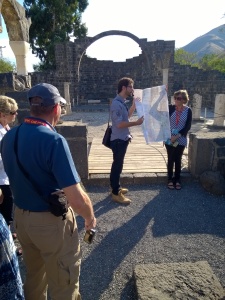








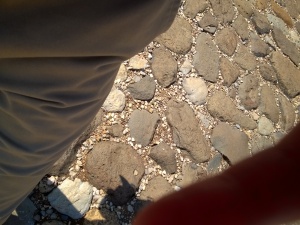







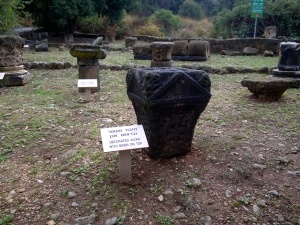








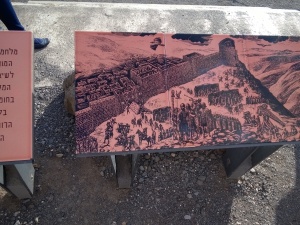
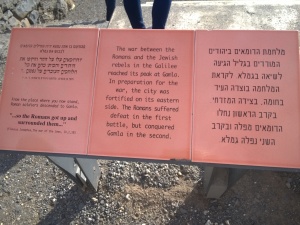

[…] https://eslc.wordpress.com/2015/10/30/day-four-tel-dan-banias-gamla-hamat-gader/ […]
LikeLike
[…] Day 4 – https://eslc.wordpress.com/2015/10/30/day-four-tel-dan-banias-gamla-hamat-gader/ […]
LikeLike